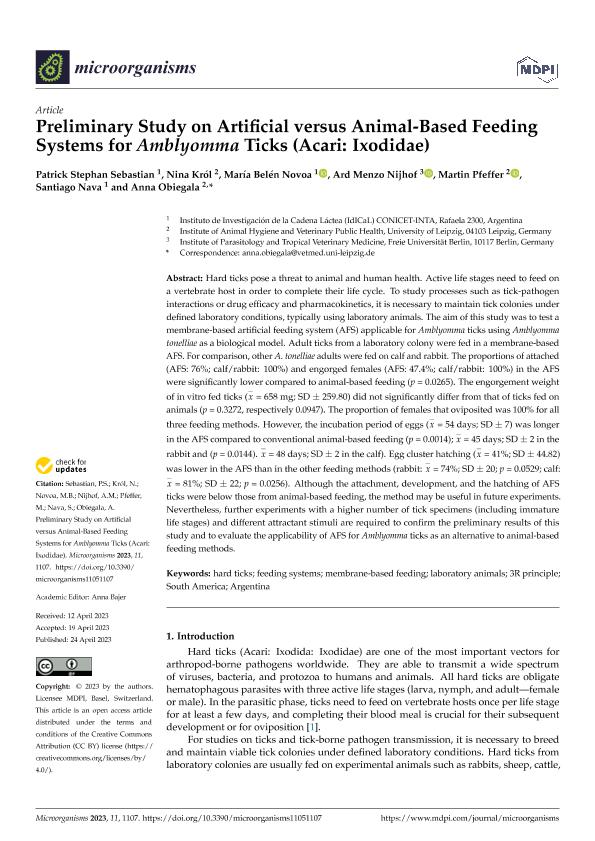Artículo
Preliminary Study on Artificial versus Animal-Based Feeding Systems for Amblyomma Ticks (Acari: Ixodidae)
Sebastian, Patrick Stephan ; Król, Nina; Novoa, María Belén
; Król, Nina; Novoa, María Belén ; Nijhof, Ard Menzo; Pfeffer, Martin; Nava, Santiago
; Nijhof, Ard Menzo; Pfeffer, Martin; Nava, Santiago ; Obiegala, Anna
; Obiegala, Anna
 ; Król, Nina; Novoa, María Belén
; Król, Nina; Novoa, María Belén ; Nijhof, Ard Menzo; Pfeffer, Martin; Nava, Santiago
; Nijhof, Ard Menzo; Pfeffer, Martin; Nava, Santiago ; Obiegala, Anna
; Obiegala, Anna
Fecha de publicación:
04/2023
Editorial:
MDPI
Revista:
Microorganisms
ISSN:
2076-2607
Idioma:
Inglés
Tipo de recurso:
Artículo publicado
Clasificación temática:
Resumen
Hard ticks pose a threat to animal and human health. Active life stages need to feed on a vertebrate host in order to complete their life cycle. To study processes such as tick-pathogen interactions or drug efficacy and pharmacokinetics, it is necessary to maintain tick colonies under defined laboratory conditions, typically using laboratory animals. The aim of this study was to test a membrane-based artificial feeding system (AFS) applicable for Amblyomma ticks using Amblyomma tonelliae as a biological model. Adult ticks from a laboratory colony were fed in a membrane-based AFS. For comparison, other A. tonelliae adults were fed on calf and rabbit. The proportions of attached (AFS: 76%; calf/rabbit: 100%) and engorged females (AFS: 47.4%; calf/rabbit: 100%) in the AFS were significantly lower compared to animal-based feeding (p = 0.0265). The engorgement weight of in vitro fed ticks ((Formula presented.) = 658 mg; SD ± 259.80) did not significantly differ from that of ticks fed on animals (p = 0.3272, respectively 0.0947). The proportion of females that oviposited was 100% for all three feeding methods. However, the incubation period of eggs ((Formula presented.) = 54 days; SD ± 7) was longer in the AFS compared to conventional animal-based feeding (p = 0.0014); (Formula presented.) = 45 days; SD ± 2 in the rabbit and (p = 0.0144). (Formula presented.) = 48 days; SD ± 2 in the calf). Egg cluster hatching ((Formula presented.) = 41%; SD ± 44.82) was lower in the AFS than in the other feeding methods (rabbit: (Formula presented.) = 74%; SD ± 20; p = 0.0529; calf: (Formula presented.) = 81%; SD ± 22; p = 0.0256). Although the attachment, development, and the hatching of AFS ticks were below those from animal-based feeding, the method may be useful in future experiments. Nevertheless, further experiments with a higher number of tick specimens (including immature life stages) and different attractant stimuli are required to confirm the preliminary results of this study and to evaluate the applicability of AFS for Amblyomma ticks as an alternative to animal-based feeding methods.
Archivos asociados
Licencia
Identificadores
Colecciones
Articulos (IDICAL)
Articulos de INSTITUTO DE INVESTIGACION DE LA CADENA LACTEA
Articulos de INSTITUTO DE INVESTIGACION DE LA CADENA LACTEA
Citación
Sebastian, Patrick Stephan; Król, Nina; Novoa, María Belén; Nijhof, Ard Menzo; Pfeffer, Martin; et al.; Preliminary Study on Artificial versus Animal-Based Feeding Systems for Amblyomma Ticks (Acari: Ixodidae); MDPI; Microorganisms; 11; 5; 4-2023; 1-10
Compartir
Altmétricas



